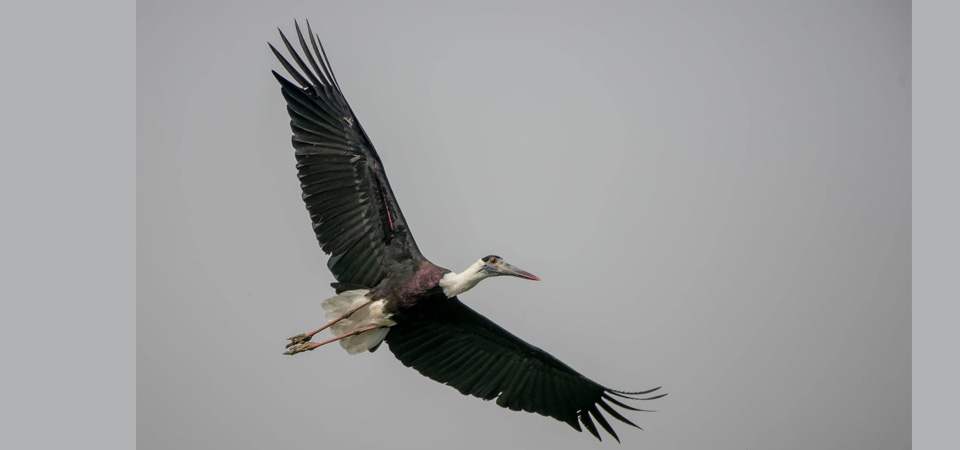Endangered woolly neck stork spotted in Bhaktapur

By A Staff Reporter
Bhaktapur, Jan. 14: The endangered bird woolly neck stork, called Lovipapi Garud in Nepali, has been spotted in and around the wetland area of Monahara of Bode in Madhyapur Thimi Municipality-8, Bhaktapur. The area is also called Mini Kositappu.
A team led by wildlife photographer and bird watcher Sanjay Tha Shrestha sighted the bird during the mid-winter waterbird count and searched it across the area from the Shalinadi River area in Kathmandu to Bode in Bhaktapur.
During the census, another endangered bird steppe Eagle which is called Gomayu Mahachil in Nepali, was also sighted in numbers of 25. Another 106 different species of birds were also found in the area, Tha Shrestha said.
The team counted the native birds found in the area along with the winter waterfowl.
The team led by Tha Shrestha included bird watchers and wildlife photographers including Ram Chandra Moyan Shrestha, Gopi Shrestha, Pemba Sherpa, Sugam Tamrakar, Satyam Pathak and Ayusha Poudel.
The team counted the birds in collaboration with the Nepal Ornithologists Association, Wetland International, Himalayan Nature, Zoological Society of London, Bird Conservation Association, Pokhara Bird Society and various other organisations.
Waterbirds come to Nepal every year from Mongolia, Siberia, Tibet and Europe to avoid freezing winter in their native land and in search for food.
Climate change, which has emerged as a global problem, has also affected bird migration.
According to Shrestha, the birds have been counted in the Manohara area to document the recent migration of birds to various wetland and coastal areas of Nepal.
During the census period, Shrestha has experienced that some birds seen in previous years have not been seen this year and some new species of birds have also been seen.
“Bird habitats are becoming more and more endangered. In such a situation, the birds seen this year may not be seen next year,” Tha Shrestha informed.
Sugam Tamrakar, another wildlife photographer who was involved in the team, said that the recent greenhouse emissions, urbanization and pollution have been causing changes in bird migration and effects.
They said that it would be of great help to spread awareness among the locals about the illegal hunting and damage to their habitats, which are threats to such migratory birds.
They complain that although the coastal area of Manohara River in Bode has been gaining popularity as Mini Kosi Tappu in recent times, the local level has not been able to come up with a conservation policy.
“Due to the rapid urbanization around the river and the pollution it has caused, there has been a shortage of fish, frogs and other aquatic animals, so these are the reasons for the reduction in the number of birds migrating periodically,” Tha Shrestha said.
He said that the illegal exploitation of riverine products including sand, which is a major problem in the coastal area, is among the reasons behind the declining number of waterbirds.
According to Tha Shrestha, the habitat of waterfowl is also at risk due to dumping of garbage in the riverside, water pollution and destruction of bird habitat in the Manohara River.
Recent News

Do not make expressions casting dout on election: EC
14 Apr, 2022
CM Bhatta says may New Year 2079 BS inspire positive thinking
14 Apr, 2022
Three new cases, 44 recoveries in 24 hours
14 Apr, 2022
689 climbers of 84 teams so far acquire permits for climbing various peaks this spring season
14 Apr, 2022
How the rising cost of living crisis is impacting Nepal
14 Apr, 2022
US military confirms an interstellar meteor collided with Earth
14 Apr, 2022
Valneva Covid vaccine approved for use in UK
14 Apr, 2022
Chair Prachanda highlights need of unity among Maoist, Communist forces
14 Apr, 2022
Ranbir Kapoor and Alia Bhatt: Bollywood toasts star couple on wedding
14 Apr, 2022
President Bhandari confers decorations (Photo Feature)
14 Apr, 2022











